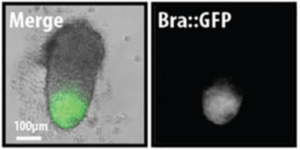Gastruloid

Gastruloids are three dimensional aggregates of mouse embryonic stem cells (ESCs) that display many features of early development such as symmetry-breaking, axial organisation, germ layer specification, polarised gene expression and axial elongation.[3] As a model system, they are highly reproducible, straightforward to generate and can be used to investigate the underlying principles and processes of early mammalian development.[3][4][5]
Background
The Gastruloid model system draws its origins from work by Marikawa et al..[6][7] In those studies, small numbers P19 embryonal carcinoma (EC) cells were aggregated as embryoid bodies (EBs) and used to investigate the processes involved in mesoderm formation.[6] Interestingly, the EBs were able to organise themselves into structures similar to the gastrulating embryo with polarised gene expression, axial elongation/organisation and up-regulation of posterior mesodermal markers. This was in stark contrast to work using EBs from mouse ESCs, where this level of organisation had not been reported, even though progenitors of axial populations can be generated in culture.[8][9]
Following this, and with modifications to the original Marikawa protocol,[3][10] the Martinez Arias laboratory in the Department of Genetics at the University of Cambridge demonstrated how aggregates of mouse ESCs were able to generate structures that exhibited collective behaviours with striking similarity to those during early development such as symmetry-breaking (in terms of gene expression), axial elongation and germ-layer specification.[3] As noted by the authors of this protocol, a crucial difference between this culture method and previous work with mouse EBs was the use of small numbers of cells which may be important for generating the correct length scale for patterning.[3][4][10]
Brachyury (T/Bra), a gene which marks the primitive streak and the site of gastrulation, is up-regulated in the Gastruloids following a pulse of the Wnt/β-Catenin agonist CHIR99021[2] (Chi; other factors have also been tested[3]) and becomes regionalised to the elongating tip of the Gastruloid. From or near the region expressing T/Bra, cells expressing the mesodermal marker tbx6 are extruded from the similar to cells in the gastrulating embryo; it is for this reason that these structures are called Gastruloids.[3]
Further reading
Martinez Arias lab website article containing up-to-date information on the history, methods and current protocols on the culture of Gatruloids and their uses.
References
- ↑ Fehling, Hans Jörg; Lacaud, Georges; Kubo, Atsushi; Kennedy, Marion; Robertson, Scott; Keller, Gordon; Kouskoff, Valerie (2003-09-01). "Tracking mesoderm induction and its specification to the hemangioblast during embryonic stem cell differentiation". Development. 130 (17): 4217–4227. doi:10.1242/dev.00589. ISSN 0950-1991. PMID 12874139.
- 1 2 Ring, David B.; Johnson, Kirk W.; Henriksen, Erik J.; Nuss, John M.; Goff, Dane; Kinnick, Tyson R.; Ma, Sylvia T.; Reeder, John W.; Samuels, Isa (2003-03-01). "Selective glycogen synthase kinase 3 inhibitors potentiate insulin activation of glucose transport and utilization in vitro and in vivo". Diabetes. 52 (3): 588–595. doi:10.2337/diabetes.52.3.588. ISSN 0012-1797. PMID 12606497.
- 1 2 3 4 5 6 7 Brink, Susanne C. van den; Baillie-Johnson, Peter; Balayo, Tina; Hadjantonakis, Anna-Katerina; Nowotschin, Sonja; Turner, David A.; Arias, Alfonso Martinez (2014-11-15). "Symmetry breaking, germ layer specification and axial organisation in aggregates of mouse embryonic stem cells". Development. 141 (22): 4231–4242. doi:10.1242/dev.113001. ISSN 0950-1991. PMC 4302915
 . PMID 25371360.
. PMID 25371360. - 1 2 Turner, David A.; Baillie-Johnson, Peter; Martinez Arias, Alfonso (2016-02-01). "Organoids and the genetically encoded self-assembly of embryonic stem cells". BioEssays. 38 (2): 181–191. doi:10.1002/bies.201500111. ISSN 1521-1878.
- ↑ Turner, David Andrew; Glodowski, Cherise R.; Luz, Alonso-Crisostomo; Baillie-Johnson, Peter; Hayward, Penny C.; Collignon, Jérôme; Gustavsen, Carsten; Serup, Palle; Schröter, Christian (2016-05-13). "Interactions between Nodal and Wnt signalling Drive Robust Symmetry Breaking and Axial Organisation in Gastruloids (Embryonic Organoids)". bioRxiv: 051722. doi:10.1101/051722.
- 1 2 Marikawa, Yusuke; Tamashiro, Dana Ann A.; Fujita, Toko C.; Alarcón, Vernadeth B. (2009-02-01). "Aggregated P19 mouse embryonal carcinoma cells as a simple in vitro model to study the molecular regulations of mesoderm formation and axial elongation morphogenesis". genesis. 47 (2): 93–106. doi:10.1002/dvg.20473. ISSN 1526-968X. PMC 3419260
 . PMID 19115346.
. PMID 19115346. - ↑ Li, Aileen S. W.; Marikawa, Yusuke (2015-12-01). "An in vitro gastrulation model recapitulates the morphogenetic impact of pharmacological inhibitors of developmental signaling pathways". Molecular Reproduction and Development. 82 (12): 1015–1036. doi:10.1002/mrd.22585. ISSN 1098-2795.
- ↑ Gadue, Paul; Huber, Tara L.; Paddison, Patrick J.; Keller, Gordon M. (2006-11-07). "Wnt and TGF-β signaling are required for the induction of an in vitro model of primitive streak formation using embryonic stem cells". Proceedings of the National Academy of Sciences. 103 (45): 16806–16811. doi:10.1073/pnas.0603916103. ISSN 0027-8424. PMC 1636536
 . PMID 17077151.
. PMID 17077151. - ↑ Kouskoff, Valerie; Lacaud, Georges; Schwantz, Staci; Fehling, Hans Jöerg; Keller, Gordon (2005-09-13). "Sequential development of hematopoietic and cardiac mesoderm during embryonic stem cell differentiation". Proceedings of the National Academy of Sciences of the United States of America. 102 (37): 13170–13175. doi:10.1073/pnas.0501672102. ISSN 0027-8424. PMC 1201570
 . PMID 16141334.
. PMID 16141334. - 1 2 Baillie-Johnson, Peter; Brink, Susanne Carina van den; Balayo, Tina; Turner, David Andrew; Arias, Alfonso Martinez. "Generation of Aggregates of Mouse Embryonic Stem Cells that Show Symmetry Breaking, Polarization and Emergent Collective Behaviour In Vitro". Journal of Visualized Experiments (105). doi:10.3791/53252. PMC 4692741
 . PMID 26650833.
. PMID 26650833.